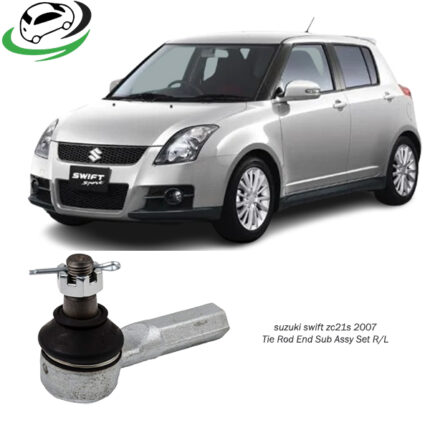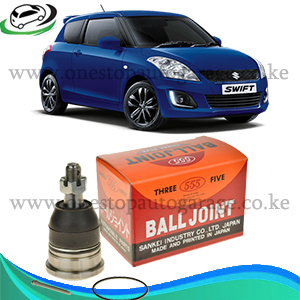-9%
Get Suzuki Swift Steering Rack End Sub-Assy SR7560 in Kenya
The steering rack end sub-assembly, often referred to simply as the rack end, is a critical component of a vehicle’s steering system. It serves as the connecting link between the steering rack and the tie rod ends, enabling the transfer of motion from the steering wheel to the wheels for directional control. Understanding its design, functions, and maintenance is essential for vehicle owners, mechanics, and automotive enthusiasts. This guide provides an in-depth explanation of the steering rack end sub-assembly, its role in the steering system, benefits, maintenance tips, and more.
What is a Steering Rack End Sub-Assembly?
The steering rack end sub-assembly is a component of the rack-and-pinion steering system, one of the most common systems in modern vehicles. It is located at the ends of the steering rack and connects to the inner tie rods, which then link to the outer tie rods and ultimately the wheels.
Key Components:
- Ball Joint:
Allows pivoting and articulation, accommodating the up-and-down movement of the wheels as they respond to road irregularities. - Threaded Shaft:
Provides adjustability for proper wheel alignment and connection to the tie rods. - Protective Boot:
Covers the assembly to prevent dust and moisture ingress.
Material Composition:
Typically made of high-strength steel or aluminum for durability and resistance to wear and tear.
Functions of the Steering Rack End Sub-Assembly
1. Motion Transfer
- Converts the rotational motion of the steering rack into linear motion to steer the wheels.
- Ensures precise and smooth directional changes.
2. Load Support
- Handles the forces exerted during turning and transmits them to the tie rods, which then relay them to the wheels.
3. Alignment Control
- Facilitates proper wheel alignment by allowing adjustments to the steering geometry.
4. Vibration Absorption
- The ball joint and boot work together to dampen vibrations from the road, enhancing steering smoothness.
Benefits of a High-Quality Steering Rack End Sub-Assembly
1. Improved Steering Responsiveness
- A well-maintained rack end ensures precise and immediate response to steering input, providing better control.
2. Enhanced Safety
- Reliable rack ends prevent loose or erratic steering, reducing the risk of accidents caused by loss of control.
3. Longevity of Other Components
- Properly functioning rack ends reduce strain on tie rods, ball joints, and other steering components, extending their lifespan.
4. Smoother Driving Experience
- By minimizing vibrations and ensuring stable wheel movement, the rack end contributes to a comfortable ride.
5. Better Tire Wear
- Proper alignment, facilitated by the rack end, prevents uneven tire wear, saving money on replacements.
Common Issues and Symptoms of Rack End Problems
Like all mechanical parts, the steering rack end sub-assembly is subject to wear and tear. Recognizing the symptoms of failure is critical for timely maintenance.
1. Loose or Wandering Steering
- A damaged or worn rack end can lead to excessive play in the steering, causing the vehicle to drift or wander.
2. Uneven Tire Wear
- Misaligned wheels due to faulty rack ends can result in uneven wear on tires.
3. Clunking or Knocking Noise
- A worn ball joint in the rack end often produces clunking noises during turns or when driving over bumps.
4. Poor Steering Feedback
- The steering may feel less responsive or overly stiff, making it harder to control the vehicle.
5. Vibrations
- Damaged rack ends can lead to vibrations in the steering wheel, especially at higher speeds.
Maintenance and Inspection Tips
1. Regular Inspections
- Include the steering rack ends in your routine vehicle inspections, especially if you frequently drive on rough roads.
2. Check for Alignment
- If you notice uneven tire wear or steering irregularities, have the wheel alignment checked. Misalignment can indicate rack end issues.
3. Monitor for Leaks
- Ensure the protective boot is intact and free from leaks or damage that could allow contaminants to enter.
4. Test Steering Play
- Excessive steering play during routine checks can point to worn or loose rack ends.
5. Replace When Necessary
- Replace the steering rack ends if you observe significant wear, damage, or failure symptoms.
Replacement Process
Replacing a steering rack end sub-assembly requires mechanical expertise. Below is an overview of the procedure:
1. Gather Tools and Parts
- New steering rack end sub-assembly
- Wrenches and socket set
- Torque wrench
- Tie rod puller
- Protective gloves
2. Prepare the Vehicle
- Lift the vehicle using a jack and secure it with jack stands.
- Remove the front wheels to access the steering components.
3. Detach the Old Rack End
- Remove the protective boot covering the rack end.
- Use a wrench to unscrew the rack end from the steering rack.
- Detach it from the inner tie rod using a tie rod puller.
4. Install the New Rack End
- Screw the new rack end onto the steering rack, ensuring proper threading and torque.
- Reattach the tie rod securely.
- Replace the protective boot and ensure a snug fit.
5. Test and Align
- Perform a wheel alignment to restore proper steering geometry.
- Test drive the vehicle to ensure smooth and responsive steering.
Factors to Consider When Choosing a Replacement Rack End
1. Compatibility
- Ensure the rack end is compatible with your vehicle’s make, model, and year.
2. Material Quality
- Opt for high-strength materials like steel or aluminum to withstand wear and harsh driving conditions.
3. Brand Reputation
- Choose reputable brands known for quality and durability, such as Febi Bilstein, MOOG, or TRW.
4. Warranty
- Look for parts that come with a manufacturer’s warranty for added peace of mind.
5. Professional Installation
- Although DIY installation is possible, professional installation ensures precision and safety.
Importance of Steering Rack End Maintenance
Maintaining the steering rack end sub-assembly is essential for the following reasons:
- Safety:
Faulty steering components can lead to accidents due to loss of vehicle control. - Cost Efficiency:
Regular maintenance prevents costly repairs by catching issues early. - Prolonged Component Lifespan:
Proper care of the rack ends reduces wear on related steering and suspension parts. - Optimal Driving Experience:
Ensures smooth, precise, and enjoyable vehicle handling.
Conclusion
The steering rack end sub-assembly plays a pivotal role in the functionality and safety of a vehicle’s steering system. Its ability to transmit motion, support alignment, and dampen vibrations ensures a smooth and controlled driving experience. Recognizing the signs of wear and adhering to regular maintenance schedules can prevent potential steering issues and costly repairs.
When replacement becomes necessary, investing in high-quality rack ends and ensuring proper installation are vital steps in maintaining vehicle performance and safety. Understanding this small but significant component underscores its importance in the overall driving experience.
Follow us on Facebook for more parts.





